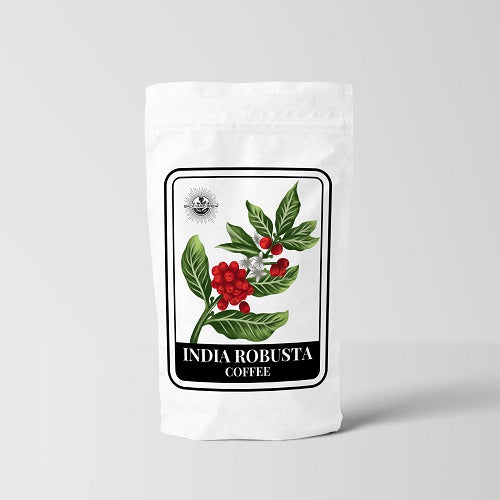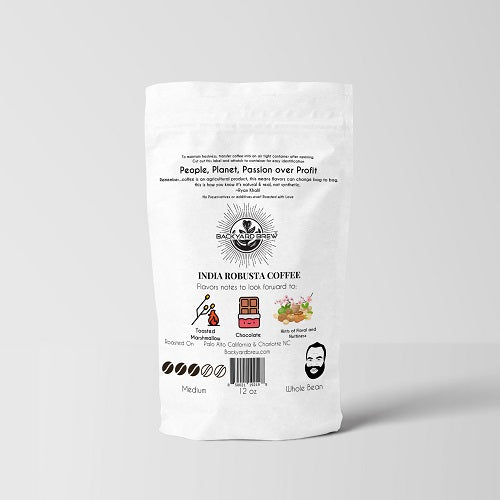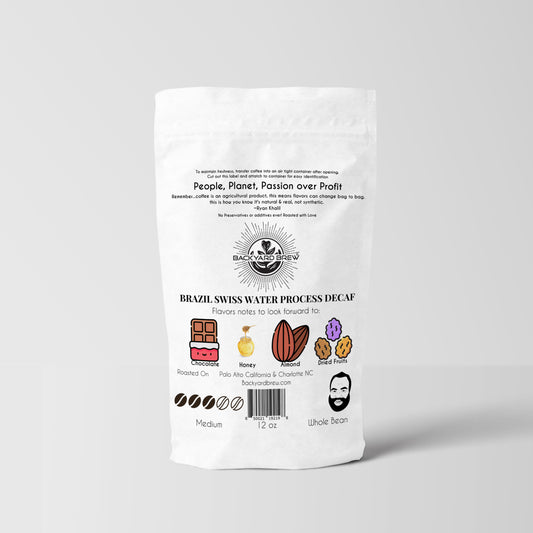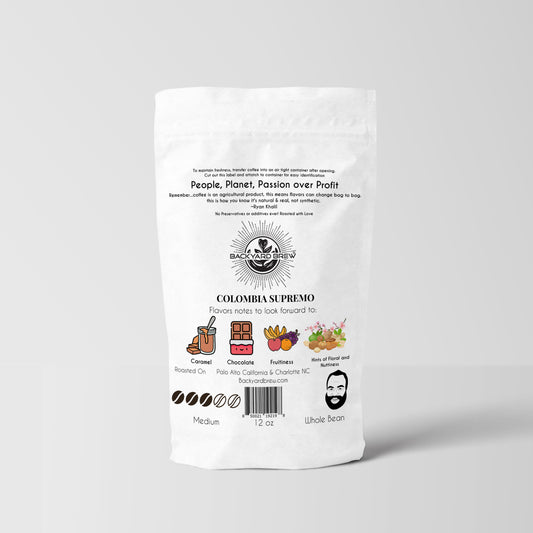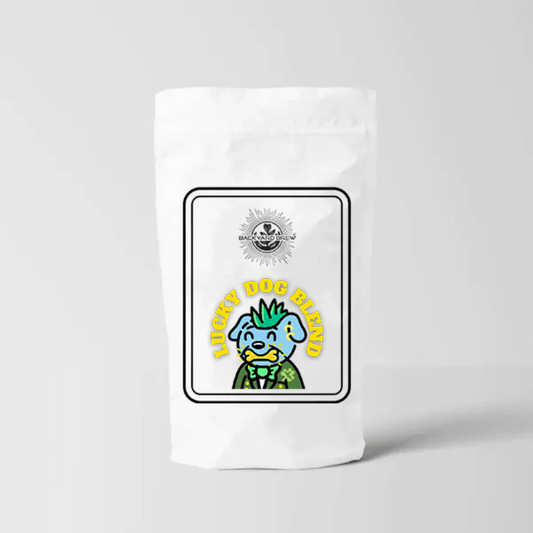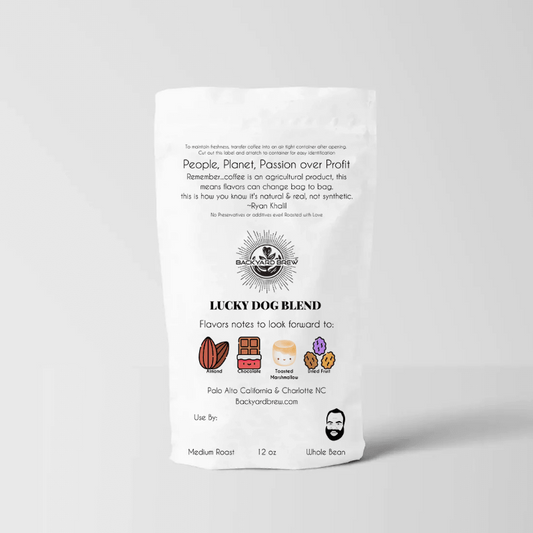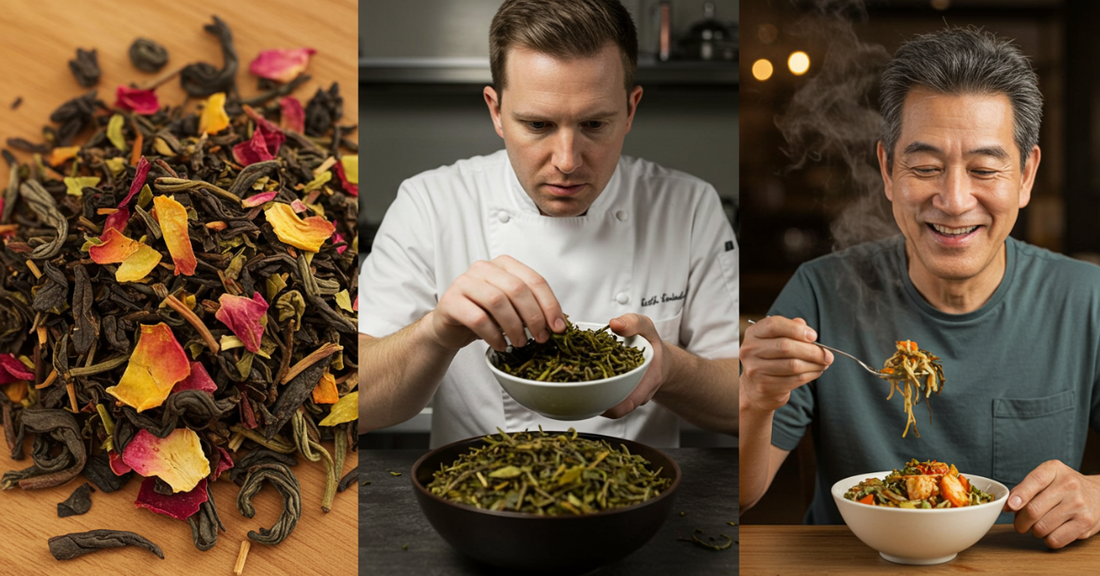Your Guide to Cooking with Tea Leaves: Delicious Savory & Sweet Dishes
Related Product
Subscribe
Table of Contents
Tea leaves are great for sipping. But did you know that you can cook with them too? Yes, that’s right! Tea is a flavorful, aromatic ingredient that amp up your cooking in surprisingly delicious ways. You can use them in both savory and sweet dishes. While it may seem such an innovation to you, it is not exactly. In fact, tea has long been used in kitchens across Asia, and it's now gaining popularity worldwide as a culinary secret weapon. Curious about how you can use tea in your meals? Well, keep reading… This guide has your how-to guide for using tea as an ingredient in your cooking.
Cooking with Different Types of Tea
Tea comes in many varieties, such as black tea, white tea, green tea, and then some. And they can add amazing flavors to your food. Moreover, the type of tea you choose can completely change a dish. In this section, we’ll explore the most popular types of tea and how they can be used to add flavor to both savory and sweet recipes.
-
Green Tea
Green tea has a clean, grassy flavor that works well in light and delicate dishes. It’s perfect for making broths, poaching fish, or cooking rice. The subtle taste of green tea doesn’t overpower other ingredients and just refines the taste of soups and steamed dishes. You can also grind dried leaves and sprinkle them over vegetables or mix them into salad dressings. Green tea is rich in antioxidants, which makes it a healthy addition to your meals. Great for cooking with green tea in Asian-inspired recipes, such as Green tea noodle soup, Cold noodle salad with sesame, and so many more.
-
Black Tea
Black tea is strong, full-bodied, and slightly bitter. This is why it is a great choice for rich, hearty foods. It pairs well with beef, chicken, and mushrooms. Use brewed black tea as a base for marinades, or reduce it to make a flavorful glaze or sauce. You can also soak dried fruits in black tea for baking. It adds color and depth to gravies and stews. Black tea works especially well in savory recipes and bold dishes like roasts and grilled meat. Besides, it can be an innovative addition to sweet dishes as well. For instance, a black tea flavored ice-cream or three milk cake or filled donuts.
-
Matcha
Matcha is a powdered green tea with a deep umami flavor and bright green color. It's often used in desserts like cakes, cookies, and ice cream. But many people don’t know that it’s also great in savory recipes like pasta dough, salad dressings, and sauces. Since matcha is very concentrated, you only need a small amount to flavor a dish. It mixes easily into liquids, so it’s ideal for batters and creams. Matcha is also high in antioxidants and adds a colorful, healthy touch to your meals. It’s a perfect tea pick for creative matcha recipes.
-
Oolong Tea
You should know that oolong tea sits between green and black tea in flavor. It has a floral, fruity, and sometimes nutty profile. This complexity makes it perfect for sauces, glazes, and even stir-fries. You can steep oolong to make a reduction for drizzling over roasted vegetables or use the brewed tea as a base for noodles. Its light bitterness and floral tones enhance both sweet and savory dishes. Oolong also works well with soy-based sauces and marinades, especially in Asian cooking. It’s also an amazing addition to baked items such as flavored sugar cookies. Fun fact: you can also spike your mojitos with oolong tea.
-
Lapsang Souchong
This one is a black tea that’s dried over pinewood fires that gives it a powerful smoky flavor. Lapsang Souchong is excellent for seasoning grilled meats, BBQ sauces, and stews. You can grind the leaves into a spice rub or use the brewed tea to marinate tofu or mushrooms. The smoky aroma mimics flavors of charred wood or smoked meat, making it a vegan-friendly way to add depth. Lapsang is ideal in hearty, rustic recipes. And undoubtedly, it’s one of the most flavorful teas for tea rubs and stews.
-
Herbal Teas
Herbal teas like chamomile, hibiscus, mint, and rooibos don’t contain caffeine and are often used in sweet dishes, mojitos, mocktails, and cocktails. Chamomile has a floral and calming flavor, so it’s great for infusing cream or milk in desserts. Hibiscus is tart and fruity, perfect for syrups, jellies, or salad dressings. Mint tea adds freshness to frozen desserts or chocolate-based recipes. Rooibos brings a natural sweetness and pairs well with vanilla and spices. These teas are great for infusing sweet dishes and syrups without artificial flavors or extra sugar. You can also use them in iced teas, lemonades, and other drinks.
Tea leaves can be used in countless ways. Since the ancient times, tea as medicine has been quite popular. And tea leaves in skincare products and recipes is also a long-followed trend. Moreover, exploring different types of tea opens up endless culinary possibilities. After all, they elevate the taste in the most unexpected ways.
|
Tea Types and Their Culinary Uses |
|||
|
Tea Type |
Flavor Profile |
Savory Uses |
Sweet Uses |
|
Green Tea |
Light, grassy, fresh |
Soups, broths, poached fish, rice dishes |
Green tea cookies, infused cream, light cakes |
|
Black Tea |
Bold, malty, strong |
Marinades, gravies, stews, sauces |
Soaking dried fruits, black tea bread, muffins |
|
Matcha |
Umami-rich, earthy, vibrant |
Pasta dough, salad dressings, seasoning sauces |
Matcha ice cream, pancakes, cookies, lattes |
|
Oolong Tea |
Floral, complex, nutty |
Stir-fries, glazes, noodle broths, soy marinades |
Oolong-infused custards, caramel sauce |
|
Lapsang Souchong |
Smoky, deep, woodsy |
Spice rubs, BBQ marinades, braises, smoked tofu |
Adds depth to chocolate desserts and truffles |
|
Chamomile |
Sweet, floral, apple-like |
Light sauces, infused oils for veggies |
Custards, panna cotta, chamomile honey syrup |
|
Hibiscus |
Tart, fruity, tangy |
Salad dressings, pickles, bright sauces |
Hibiscus syrups, jellies, iced desserts |
|
Mint Tea |
Cool, refreshing |
Yogurt dips, sauces, herbal butters |
Mint chocolate treats, ice cream, tea syrups |
|
Rooibos |
Sweet, woody, mild |
Glazes, spice blends, vegan stews |
Rooibos crème brûlée, spiced cakes, vanilla desserts |
Why Use Tea Leaves in Cooking?
Tea leaves can add incredible flavor and depth to food. Each type of tea has a unique taste: green tea is fresh and grassy, black tea is bold and malty, and smoky teas like Lapsang Souchong bring a deep, earthy note. These flavors can enhance both savory and sweet dishes in creative ways. Tea is also full of antioxidants and nutrients.
Some teas help with digestion, reduce inflammation, and support the immune system. Cooking with tea is also a great way to reduce food waste. If you have extra or already-steeped tea leaves, you can reuse them in broths, marinades, or even baked goods. It’s sustainable and smart. Moreover, tea can be used as a natural seasoning. Instead of using too much salt or sugar, tea adds a subtle, rich flavor without extra calories. It’s perfect for anyone looking to eat cleaner without sacrificing taste.
Cooking Techniques Using Tea Leaves
Cooking with tea leaves is easy once you learn a few basic techniques. These include infusing, grinding, steeping, or even smoking to incorporate the bold flavors into your recipes. Here's how to get started with tea-infused recipes using common cooking methods:
Infusing Tea in Water, Milk, Cream, or Broth
One of the easiest ways to use tea in cooking is by infusing it into liquids. Simply steep the tea leaves in hot water, milk, cream, or broth, just like you would for a cup of tea. Here are some tips you can follow for this:
-
Use green or jasmine tea in rice water for a delicate flavor.
-
Steep black tea in cream for custards or ice cream bases.
-
Add chamomile or rooibos to warm milk for baking.
-
Use oolong or lapsang in soup or stew broths for depth.
This technique helps tea flavor gently soak into your dish without overpowering it. It’s perfect for tea-infused recipes that call for a subtle, aromatic touch.
Grinding Tea Leaves into Powder
Grinding dried tea leaves turns them into a fine powder. This is useful for spice rubs, seasoning blends, and baking. Choosing the right type of tea for grinding is what makes this technique a success. Here are some grinding tips for you:
-
Use a spice grinder or mortar and pestle.
-
Add ground matcha or black tea to cookie dough or cake batter.
-
Mix lapsang powder with salt and garlic for a smoky meat rub.
This method delivers bold flavor and color. It works well when you want tea to act as a seasoning or a flour substitute in small amounts. It’s great for making your own tea rubs.
-
Steeping for Sauces and Reductions
You can also steep tea leaves directly into hot liquids, then reduce them to make sauces, glazes, or syrups. This is a great method to elevate your steaks, gravies, sauces, and margination. Here’s what you can do:
-
Steep hibiscus tea in sugar water for a tart syrup.
-
Use earl grey in butter or cream sauces for chicken or fish.
-
Add mint or rooibos tea to honey-based reductions.
Once reduced, these liquids thicken and concentrate the tea’s flavor. They’re great drizzled over desserts, stirred into stir-fries, or brushed onto proteins.
-
Smoking Food with Dry Tea Leaves
Dry tea leaves can also be used for smoking food. You may have heard about this technique for the first time. But trust me, it adds a deep aroma and flavor.
-
Use lapsang souchong, black tea, or oolong as the smoke base.
-
Combine tea leaves with uncooked rice and sugar in foil or a wok.
-
Place food over it (like tofu, duck, or vegetables) and cover tightly.
The tea smoke infuses the food, giving it a woodsy, BBQ-like flavor without needing a smoker. This is especially useful in small kitchens or for indoor smoking. It’s a unique way to impress with tea-infused recipes.
Tea is incredibly versatile in the kitchen. Once you try these techniques, you'll see how easy it is to use tea for cooking, seasoning, and flavoring all kinds of dishes, be they appetizers or desserts.
Cooking Savory Dishes Using Tea Leaves
If you have come reading this far, you know teas are used in so many savory foods. Here are our top picks for your tea-added meals:
-
Tea-Infused Broths and Soups
As aforementioned, tea adds a delicate flavor and health benefits to broths and soups. In green tea miso soup, the earthy notes of green tea pair beautifully with miso, tofu, and seaweed. It’s light, clean, and rich in antioxidants. For a deeper taste, try black tea ramen broth; the black tea adds richness to the stock, especially when simmered with garlic, soy sauce, and mushrooms. These tea soup recipes are great for warm, comforting meals with a unique twist.
-
Tea-Rubbed or Tea-Smoked Meat
Lapsang Souchong tea-smoked chicken has a deep, smoky flavor thanks to the pinewood-dried leaves. It’s perfect for oven smoking or grilling. Matcha-crusted salmon uses powdered green tea as a light, earthy crust that pairs well with citrus or soy glaze. Oolong tea-rubbed pork chops bring floral, slightly sweet notes to hearty meat dishes. These savory tea recipes are ideal for dinner or special meals.
-
Tea in Grains, Rice & Noodles
Jasmine tea rice is fragrant and floral, perfect as a side dish with fish or stir-fry. Try Earl Grey quinoa for something more citrusy; it pairs beautifully with roasted vegetables. For noodles, cook tea-infused soba in green or oolong tea instead of water to add depth. These ideas make simple grains more exciting using natural, flavorful tea infusions.
-
Tea-Based Sauces, Dressings & Marinades
A green tea ginger vinaigrette is fresh, slightly spicy, and perfect for salads or grain bowls. For plant-based meals, try a black tea and soy marinade for tofu—it gives umami depth and caramel color to tofu, mushrooms, or eggplant. These tea marinades and dressings are simple to make and add complexity without added fats or artificial flavoring.
Sweet Dishes Using Tea Leaves
Undoubtedly, tea is the star of many desserts, be it ice cream or cakes. Another amazing thing is that, it’s the perfect experimental ingredient for your sweet dishes. Here are our top sweet recipes for tea as ingredients:
-
Baked Goods with Tea
Tea is perfect for baking and adds natural flavor without extra sugar. Earl Grey tea cookies are buttery with a soft citrusy bite. Matcha muffins are moist and earthy, often paired with white chocolate or berries. Chai-spiced banana bread uses ground tea leaves or steeped milk for warm, spiced flavor. These tea dessert recipes are easy to make and always stand out.
-
Creamy Tea-Infused Desserts
Infusing cream or milk with tea makes elegant, aromatic desserts. Green tea or matcha ice cream is smooth, slightly bitter, and deeply refreshing. It’s one of the most popular matcha sweets worldwide. Chamomile panna cotta is light and floral, ideal for a relaxing dessert. For something rich, try rooibos crème brûlée; it’s a master-chef-level delight.
-
Tea Syrups, Jellies & Candy
Tea-based syrups and candies are creative and full of flavor. Hibiscus tea syrup is tangy and bright. Hence, it pairs great in cocktails, mocktails, or over pancakes. Mint tea jelly pairs well with cheese or roasted lamb, adding a fresh herbal layer. Tea caramel candies, made by infusing cream with black tea or chai, offer a unique twist on traditional sweets. These tea candies and syrups are great for gifts or gourmet treats.
5 Best Backyard Brew Teas for Your Savory & Sweet Dishes
At Backyard Brew tea blends, we have a diverse collection of premium organic tea. From black tea to herbal tea and white tea, you name it, we have it. And they don’t just elevate your sipping time but can also refine your culinary experience. Here are our top 5 picks for your cooking experiments.
1. Blazing Red Rooibos
This rich, earthy rooibos has warm, naturally sweet notes. In savory items, our blazing red rooibos blends beautifully. Hence, it is a flavorful choice for spice rubs or glazes for roasted vegetables and ribs. In sweet dishes, it makes creamy custards or chai-style puddings that shine with natural caramel undertones. Rooibos is caffeine-free and full of antioxidants which makes it perfect for comforting yet healthy recipes.
2. Moroccan Rose Dance
This one is a delicate floral blend combining rose petals and soothing herbs. Use it to infuse simple syrups or honeys for salad dressings and fruit glazes. It also shines in desserts; try it in panna cotta, ice creams, or infused whipped creams for a beautiful rose aroma and light sweetness.
3. Egyptian Chamomile
Soft, apple-like chamomile is perfect for gentle, mellow flavors. It works in creamy pasta sauces, light broths, or as an infusion in olive oil for drizzling over grilled fish or veggies. For sweets, steep it in milk or cream to make custards, puddings, or silky teas for tea cakes and ice creams.
5. Jordanian Chai Mix
It’s warming blend of black tea and spices. You can use Jordanian Chai Mix to infuse dairy or plant-based milk for creamy chai sauces, marinades for tofu or chicken, and spice-laden curries. In sweet dishes, the uses are endless. You can steep it in milk for puddings, rice pudding, or chai cookies and spiced cakes.
4. Grandma’s Tea (Black Tea)
A classic, full-bodied tea, Grandma’s Tea is one of Backyard Brew’s most versatile blends. It preserves the rich, premium flavor of traditional black tea. You can use it for both savory and sweet dishes. Use it in marinades for meats, gravies, or to steep dried fruits. For desserts, it adds depth to cakes, puddings, or even ice cream bases. This everyday staple is a must-have for any tea-inspired kitchen.
|
Top 5 Backyard Brew Teas & Their Uses in Cooking |
||
|
Tea Name |
Savory Uses |
Sweet Uses |
|
Blazing Red Rooibos |
Glazes, roasted veggies, spice rubs |
Custards, puddings, caramel-style desserts |
|
Moroccan Rose Dance |
Rose syrup glazes, dressings |
Ice cream, panna cotta, infused whipped cream |
|
Egyptian Chamomile |
Light broths, pasta sauces, herb oils |
Custards, tea cakes, creamy desserts |
|
Jordanian Chai Mix |
Marinades, curry bases, chai sauces |
Chai rice pudding, cookies, spiced cakes |
|
Grandma’s Tea (Black) |
Marinades, gravies, tea-braised meats |
Tea-infused cake, puddings, fruit soaks, ice cream base |
So, your favorite Backyard Brew tea blends are not just for sipping. They’re great ingredients for a range of dishes. These stand out for their distinct flavor profiles, health-promoting herbs, and dual-purpose use in both savory and dessert cooking. Try them in your next recipe and enjoy the aromatic depth they bring!
Conclusion
Cooking with tea leaves opens up a world of flavors. This blog is your guide on different ways you can use tea as an ingredient. From black tea to the famous matcha, each brings a unique deliciousness to the dishes. Besides, you can use tea in so many food items, such as broths, desserts, marinades, noodles, pastas, and whatnot. Don’t know where to find high-quality tea for your culinary experiments. Hop on to Backyard Brew! Our blends fit well in both savory and sweet dishes. So next time you're in the kitchen, you know how to make cooking more fun and exciting: by adding tea to your recipes.

